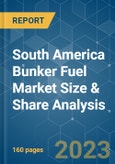The South American bunker fuel market is expected to reach USD 8.72 billion by the end of this year growing at a CAGR of more than 2% over the forecast period.
The bunker fuel market in South America is mainly driven by the ever-rising marine transportation of essential commodities, implementation of the stricter environmental regulations driving the demand for cleaner bunker fuels, and the increase in the use of marine vessels for offshore oil and gas developments.
However, the oil market’s volatility is significantly expected to affect the bunker fuel market as it can impact the profitability of bunker fuel suppliers and make planning and investing difficult.
Brazil is expected to dominate the bunker fuel market in the region owing to factors like huge crude oil production and a steady rise in exports from the country.
The bunker fuel market in South America is mainly driven by the ever-rising marine transportation of essential commodities, implementation of the stricter environmental regulations driving the demand for cleaner bunker fuels, and the increase in the use of marine vessels for offshore oil and gas developments.
However, the oil market’s volatility is significantly expected to affect the bunker fuel market as it can impact the profitability of bunker fuel suppliers and make planning and investing difficult.
Brazil is expected to dominate the bunker fuel market in the region owing to factors like huge crude oil production and a steady rise in exports from the country.
South America Bunker Fuel Market Trends
Very Low Sulfur Fuel Oil (VLSFO) to Witness Significant Growth
- The demand for very low sulfur fuel oil (VLSFO) in the South African Bunker fuel market has seen a significant rise in recent years, following the International Maritime Organization's (IMO) mandate on reducing sulfur emissions from ships.
- As of April 2023, VLSFO availability is particularly strained in the domestic bunker fuel market, as most of the VLSFO used in the South Africa bunker fuel market is imported. Low-sulfur fuel oil is available in the ports of Durban, Port Elizabeth, and Cape Town, as well as at offshore bunkering in AlgoaBay (off Port Elizabeth and Ngqura).
- In October 2022, FUEL & MARINE OIL CORP (FAMOIL), a commodity trading house specializing in the marine fuel industry, added a bunker delivery vessel to its operation in Peru. The company added the tanker Ecomar II to its fleet. The vessel supplies Very Low Sulfur Fuel Oil (VLSFO) and High Sulfur Fuel Oil at Talara, Paita, Bayovar, Salaverry, Chimbote ports Pisco, San Nicolas, Matarani, and Llo.
- Moreover, the demand for VLSFO in the South American market is also driven by the growing number of vessels operating in the region.
- Overall, the market is expected to witness significant growth during the forecast period owing to factors like increasing demand which spurge up after the implementation of the IMO sulfur cap.
Brazil to Dominate the Market
- Brazil is the largest economy in the region and is expected to be the fastest-growing economy in the forecast period. The country is one of the fastest-growing countries worldwide because of the increasing population, industrialization, and urbanization.
- In 2023, Ipiranga Produtos de Petroleo, a Brazilian bunker fuel supplier, commenced physical delivery of bunker fuels at the southern port of Rio Grande.
- Brazil owns the largest recoverable ultra-deep oil reserves in the world, with 96.7% of Brazil’s oil production produced offshore. The 2021 average oil production was 2.90 million barrels per day.
- Hence, with the expected increase in oil and gas production, trading activities are expected to increase further between Brazil and the rest of the world. With major international trading activities carried out through the marine route, Brazil is expected to become the emerging market for bunker fuel in the near future.
- All of the above factors are expected to help the country dominate the region in terms of bunker fuel during the forecast period.
South America Bunker Fuel Industry Overview
The South American bunker fuel market is moderately fragmented. Some of the key players in this market include Bunker Holding A/S, Monjasa Holding A/S, AP Moeller Maersk A/S, World Fuel Services Corp, and Peninsula Petroleum Ltd.Additional Benefits:
- The market estimate (ME) sheet in Excel format
- 3 months of analyst support
Table of Contents
1 INTRODUCTION
4 MARKET OVERVIEW
5 MARKET SEGMENTATION
6 COMPETITIVE LANDSCAPE
Companies Mentioned (Partial List)
A selection of companies mentioned in this report includes, but is not limited to:
- Fuel Suppliers
- Ship Owners
Methodology

LOADING...










